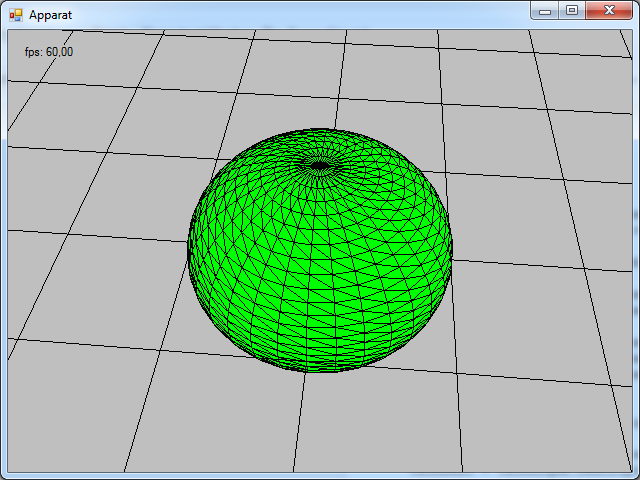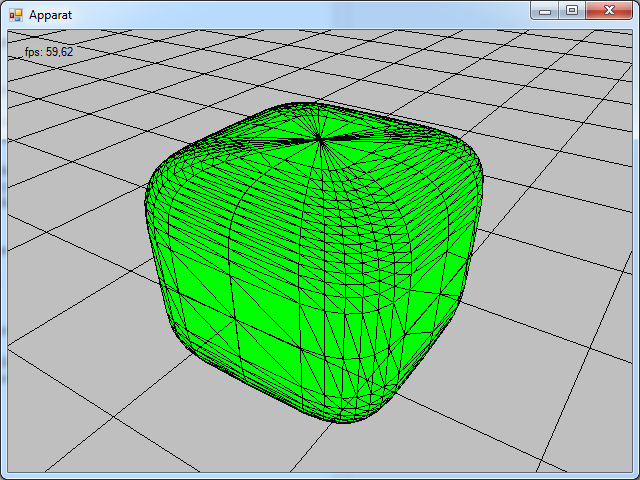Introduction
This tutorial is one part of a series of tutorials about generating procedural meshes. See here for an outline.
The superellipsoid is basically a sphere with additional exponents n1 and n2 for manipulating the trigonometric functions. You can create cubes with round edges, a cube, a sphere, a cylinder and many other geometric objects with it, when using the according values for n1 and n2.
The Formula
I took the formula for the superellipsoid from:http://paulbourke.net/geometry/superellipse/
x = radius * Cos^n1(theta) * Cos^n2(phi)
y = radius * Cos^n1(theta) * Sin^n2(phi)
z = radius * Sin^n1(theta)
Basically, this is the same formula as for the sphere, with two additional exponents n1 and n2. Both, n1 and n2 have to be bigger than 0 to produce valid meshes. Although values over 10 don't add any significant change to the appearence of the mesh. Play around with the parameters and see for yourself ;)
Creating the Vertex Buffer
Theta runs in the outer loop from PI/2 to -PI/2 and phi runs from zero to 2*PI.I think the only obscure thing in the code is use of the Math.Pow function.
At first, I check if cosTheta, sinTheta, cosPhi and sinPhi are zero. If they are zero, 0 is asigned to the according powX variables. Then I have to check, if for example cosTheta is a negative value.
Small negative values can produce a NaN (Not A Number) value from the Math.Pow function.
Instead of
Math.Pow( - littleNumber, anyOtherNumber ),
I am calculating:
- Math.Pow( littleNumber, anyOtherNumber )
int numHorizontalVertices = numVerticesPerLayer + 1;
int numVerticalVertices = numVerticesPerLayer + 1;
numVertices = numHorizontalVertices * numVerticalVertices;
vertexSizeInBytes = 12;
int vertexBufferSizeInBytes = vertexSizeInBytes * numVertices;
vertices = new DataStream(vertexBufferSizeInBytes, true, true);
float theta = 0.0f;
float phi = 0.0f;
float verticalStep = ((float)Math.PI) / (float)numVerticesPerLayer;
float horizontalStep = ((float)Math.PI * 2) / (float)numVerticesPerLayer;
for (int verticalIt = 0; verticalIt < numVerticalVertices; verticalIt++)
{
theta = ((float)Math.PI / 2) - verticalStep * verticalIt;
for (int horizontalIt = 0; horizontalIt < numHorizontalVertices; horizontalIt++)
{
phi = horizontalStep * horizontalIt;
double cosTheta = Math.Cos(theta);
double sinTheta = Math.Sin(theta);
double cosPhi = Math.Cos(phi);
double sinPhi = Math.Sin(phi);
double powCosTheta = cosTheta == 0.0f ? 0 : Math.Sign(cosTheta) == -1 ? -Math.Pow(-cosTheta, n1) : Math.Pow(cosTheta, n1);
double powSinTheta = sinTheta == 0.0f ? 0 : Math.Sign(sinTheta) == -1 ? -Math.Pow(-sinTheta, n1) : Math.Pow(sinTheta, n1);
double powCosPhi = cosPhi == 0.0f ? 0 : Math.Sign(cosPhi) == -1 ? -Math.Pow(-cosPhi, n2) : Math.Pow(cosPhi, n2);
double powSinPhi = sinPhi == 0.0f ? 0 : Math.Sign(sinPhi) == -1 ? -Math.Pow(-sinPhi, n2) : Math.Pow(sinPhi, n2);
double x = radius * powCosTheta * powCosPhi;
double y = radius * powCosTheta * powSinPhi;
double z = radius * powSinTheta;
Vector3 v = new Vector3((float)x, (float)z, (float)y);
vertices.Write(v);
}
}
vertices.Position = 0;
// create the vertex layout and buffer
var elements = new[] {
new InputElement("POSITION", 0, Format.R32G32B32_Float, 0),
};
layout = new InputLayout(DeviceManager.Instance.device, inputSignature, elements);
vertexBuffer = new SlimDX.Direct3D11.Buffer(DeviceManager.Instance.device,
vertices,
vertexBufferSizeInBytes,
ResourceUsage.Default,
BindFlags.VertexBuffer,
CpuAccessFlags.None,
ResourceOptionFlags.None, 0);
Creating the Index Buffer
Nothing new here, please refer to the grid mesh tutorial for details.numIndices = 6 * numVertices;
indices = new DataStream(2 * numIndices, true, true);
try
{
for (int verticalIt = 0; verticalIt < numVerticesPerLayer; verticalIt++)
{
for (int horizontalIt = 0; horizontalIt < numVerticesPerLayer; horizontalIt++)
{
short lu = (short)(horizontalIt + verticalIt * (numHorizontalVertices));
short ru = (short)((horizontalIt + 1) + verticalIt * (numHorizontalVertices));
short ld = (short)(horizontalIt + (verticalIt + 1) * (numHorizontalVertices));
short rd = (short)((horizontalIt + 1) + (verticalIt + 1) * (numHorizontalVertices));
indices.Write(lu);
indices.Write(rd);
indices.Write(ld);
indices.Write(rd);
indices.Write(lu);
indices.Write(ru);
}
}
}
catch (Exception ex)
{
}
indices.Position = 0;
indexBuffer = new SlimDX.Direct3D11.Buffer(
DeviceManager.Instance.device,
indices,
2 * numIndices,
ResourceUsage.Default,
BindFlags.IndexBuffer,
CpuAccessFlags.None,
ResourceOptionFlags.None,
0);
Source Code
using System;
using System.Collections.Generic;
using System.Linq;
using System.Text;
using SlimDX.D3DCompiler;
using SlimDX;
using SlimDX.Direct3D11;
using SlimDX.DXGI;
using System.Runtime.InteropServices;
namespace Apparat.Renderables
{
public class SuperEllipsoid : Renderable
{
SlimDX.Direct3D11.Buffer vertexBuffer;
SlimDX.Direct3D11.Buffer indexBuffer;
DataStream vertices;
DataStream indices;
int vertexSizeInBytes;
InputLayout layout;
int numVertices = 0;
int numIndices = 0;
ShaderSignature inputSignature;
EffectTechnique technique;
EffectPass pass;
Effect effect;
EffectMatrixVariable tmat;
EffectVectorVariable mCol;
EffectVectorVariable wfCol;
double n1 = 0;
double n2 = 0;
float radius = 0.0f;
public SuperEllipsoid(int numVerticesPerLayer, float radius, float n1, float n2)
{
try
{
this.n1 = n1;
this.n2 = n2;
this.radius = radius;
using (ShaderBytecode effectByteCode = ShaderBytecode.CompileFromFile(
"Shaders/transformEffectWireframe.fx",
"Render",
"fx_5_0",
ShaderFlags.EnableStrictness,
EffectFlags.None))
{
effect = new Effect(DeviceManager.Instance.device, effectByteCode);
technique = effect.GetTechniqueByIndex(0);
pass = technique.GetPassByIndex(0);
inputSignature = pass.Description.Signature;
}
}
catch (Exception ex)
{
Console.WriteLine(ex.ToString());
}
tmat = effect.GetVariableByName("gWVP").AsMatrix();
mCol = effect.GetVariableByName("colorSolid").AsVector();
wfCol = effect.GetVariableByName("colorWireframe").AsVector();
mCol.Set(new Color4(1, 0, 1, 0));
wfCol.Set(new Color4(1, 0, 0, 0));
int numHorizontalVertices = numVerticesPerLayer + 1;
int numVerticalVertices = numVerticesPerLayer + 1;
numVertices = numHorizontalVertices * numVerticalVertices;
vertexSizeInBytes = 12;
int vertexBufferSizeInBytes = vertexSizeInBytes * numVertices;
vertices = new DataStream(vertexBufferSizeInBytes, true, true);
float theta = 0.0f;
float phi = 0.0f;
float verticalStep = ((float)Math.PI) / (float)numVerticesPerLayer;
float horizontalStep = ((float)Math.PI * 2) / (float)numVerticesPerLayer;
for (int verticalIt = 0; verticalIt < numVerticalVertices; verticalIt++)
{
theta = -((float)Math.PI / 2) + verticalStep * verticalIt;
for (int horizontalIt = 0; horizontalIt < numHorizontalVertices; horizontalIt++)
{
phi = horizontalStep * horizontalIt;
double cosTheta = Math.Cos(theta);
double sinTheta = Math.Sin(theta);
double cosPhi = Math.Cos(phi);
double sinPhi = Math.Sin(phi);
double powCosTheta = cosTheta == 0.0f ? 0 : Math.Sign(cosTheta) == -1 ? -Math.Pow(-cosTheta, n1) : Math.Pow(cosTheta, n1);
double powSinTheta = sinTheta == 0.0f ? 0 : Math.Sign(sinTheta) == -1 ? -Math.Pow(-sinTheta, n1) : Math.Pow(sinTheta, n1);
double powCosPhi = cosPhi == 0.0f ? 0 : Math.Sign(cosPhi) == -1 ? -Math.Pow(-cosPhi, n2) : Math.Pow(cosPhi, n2);
double powSinPhi = sinPhi == 0.0f ? 0 : Math.Sign(sinPhi) == -1 ? -Math.Pow(-sinPhi, n2) : Math.Pow(sinPhi, n2);
double x = radius * powCosTheta * powCosPhi;
double y = radius * powCosTheta * powSinPhi;
double z = radius * powSinTheta;
Vector3 v = new Vector3((float)x, (float)z, (float)y);
vertices.Write(v);
}
}
vertices.Position = 0;
// create the vertex layout and buffer
var elements = new[] {
new InputElement("POSITION", 0, Format.R32G32B32_Float, 0),
};
layout = new InputLayout(DeviceManager.Instance.device, inputSignature, elements);
vertexBuffer = new SlimDX.Direct3D11.Buffer(DeviceManager.Instance.device,
vertices,
vertexBufferSizeInBytes,
ResourceUsage.Default,
BindFlags.VertexBuffer,
CpuAccessFlags.None,
ResourceOptionFlags.None, 0);
// creating the index buffer
numIndices = 6 * numVertices;
indices = new DataStream(2 * numIndices, true, true);
try
{
for (int verticalIt = 0; verticalIt < numVerticesPerLayer; verticalIt++)
{
for (int horizontalIt = 0; horizontalIt < numVerticesPerLayer; horizontalIt++)
{
short lu = (short)(horizontalIt + verticalIt * (numHorizontalVertices));
short ru = (short)((horizontalIt + 1) + verticalIt * (numHorizontalVertices));
short ld = (short)(horizontalIt + (verticalIt + 1) * (numHorizontalVertices));
short rd = (short)((horizontalIt + 1) + (verticalIt + 1) * (numHorizontalVertices));
indices.Write(lu);
indices.Write(rd);
indices.Write(ld);
indices.Write(rd);
indices.Write(lu);
indices.Write(ru);
}
}
}
catch (Exception ex)
{
}
indices.Position = 0;
indexBuffer = new SlimDX.Direct3D11.Buffer(
DeviceManager.Instance.device,
indices,
2 * numIndices,
ResourceUsage.Default,
BindFlags.IndexBuffer,
CpuAccessFlags.None,
ResourceOptionFlags.None,
0);
}
public override void render()
{
Matrix ViewPerspective = CameraManager.Instance.ViewPerspective;
tmat.SetMatrix(ViewPerspective);
// configure the Input Assembler portion of the pipeline with the vertex data
DeviceManager.Instance.context.InputAssembler.InputLayout = layout;
DeviceManager.Instance.context.InputAssembler.PrimitiveTopology = PrimitiveTopology.TriangleList;
DeviceManager.Instance.context.InputAssembler.SetVertexBuffers(0, new VertexBufferBinding(vertexBuffer, vertexSizeInBytes, 0));
DeviceManager.Instance.context.InputAssembler.SetIndexBuffer(indexBuffer, Format.R16_UInt, 0);
technique = effect.GetTechniqueByName("Render");
EffectTechniqueDescription techDesc;
techDesc = technique.Description;
for (int p = 0; p < techDesc.PassCount; ++p)
{
technique.GetPassByIndex(p).Apply(DeviceManager.Instance.context);
DeviceManager.Instance.context.DrawIndexed(numIndices, 0, 0);
}
}
public override void dispose()
{
indexBuffer.Dispose();
vertexBuffer.Dispose();
effect.Dispose();
}
}
}
Result
All meshes shown below were created with radius = 1.0 and 32 * 32 vertices mesh.
Only the values for n1 and n2 differ.
n1 = 0 and n2 = 0:
n1 = 0 and n2 = 1:
n1 = 1 and n2 = 0:
n1 = 1 and n2 = 1:
n1 = 0.4 and n2 = 0.4:
n1 = 2 and n2 = 2:
n1 = 4 and n2 = 4:
I added a second class SuperEllipsoidCol which has the same colors as the color cube:
With 32 x 32 vertices, radius 0.5, n1 = 0.2 and n2 = 0.2:
You can download the source code for this tutorial here. You can play around with the parameters in the RenderControl.cs class.
Have fun!








No comments:
Post a Comment